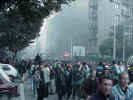|

of the Belgrade Coup
Editor & Webmaster
Leon Chame - 2008
Yugoslav Associates:
- Zoran Radojicic
- Dejan Vukelic
- George Orwell
Contributing Websites:
- Original Sorces
- Transnational (TFF)
- Fair sources
- WSWS
avgust 20, 2008
| |
A U.S. military ring around Yugoslavia
Washington did not simply sit on the sidelines, however,
making self-serving propaganda through its media. It
simultaneously laid the groundwork for eventual military
intervention by U.S. troops.
This began in 1992, when the Clinton administration sent 300
troops in Macedonia, as part of the UN "peacekeeping" mission
there. They were later increased to 500. Today U.S. troops are
part of the 12,000-strong NATO force there.
After the pro-capitalist regime of Sali Berisha won the
presidency in neighboring Albania in 1992, the U.S. government
struck a military agreement with Tirana, in exchange for
economic bribes, which allowed the U.S. air force to use an air
base in northern Albania for reconnaissance over Bosnia. Later,
Clinton struck another agreement with the government of
Hungary, which paved the way for U.S. troops to be transported
on land from Germany to Bosnia as part of the 1995 NATO
invasion. NATO's sixth fleet was dispatched in the Adriatic off
Yugoslavia's coast and has remained a more-or-less permanent
presence there ever since.
In short, Washington built an entire military ring around
Yugoslavia.
Simultaneously, the White House made sure some weapons got
into Bosnia during the UN arms embargo on that republic, which
Washington had voted for in the UN. But Washington made sure
that not enough heavy artillery was sent to the Bosnian regime
of Alija Izetbegovic to tip the balance of power and endanger
an outright victory for its armed forces over Belgrade.
That's what happened when Clinton encouraged Izetbegovic to
launch a military offensive in the summer of 1994. The weaponry
and ammunition the Bosnian army possessed was enough to enable
it to conquer some ground but not to help guarantee victory.
Washington used the regime in Zagreb, Croatia's capital, for
that purpose, which sifted through arms shipments and let
through to Bosnia only what the U.S. rulers approved. By that
time, the U.S. government had displaced Bonn in military and
diplomatic influence in Zagreb.
In the summer of 1995, the Croatian government carried out a
massive offensive, with Washington's green light and aid, in
the majority Serb region of Krajina in Croatia. This resulted
in one of the biggest "ethnic cleansing" operations in the war,
displacing 150,000 people of Serbian origin from their homes
and killing many in the process. This was not presented for
what it was in the U.S. media, unlike similar operations by
Belgrade in Bosnia.
That offensive, and the resistance by pro-Belgrade forces in
Bosnia to it, set the stage for the 1995 NATO bombing in Bosnia
and the signing of the Dayton accords in November of that year.
Throughout these years, Washington humiliated its
competitors in France, Germany, and Britain that had sent
thousands of troops to Bosnia. The French and British troops
came to be increasingly seen by many in Yugoslavia and in
bourgeois public opinion in the United States as responsible
for the ongoing killing to a degree, or at least as unable to
bring peace and to stop the slaughter.
Why wasn't there a Madrid agreement, a Lisbon, a Paris, a
Stockholm, Belgrade, or Hague agreement? Because Washington
sabotaged them all. Who remembers any of these potential
accords? No one. Who remembers the politicians like Carl Bildt,
the former Swedish prime minister, assigned to bring them to
fruition? No one. Washington humbled the authors of those plans
and the powers behind them - Bonn, Stockholm, and Paris. Every
time an agreement seemed close to be struck, there was another
slaughter to derail it.
The bourgeois myth that the cause was "age-old ethnic
hatreds," to which the Balkan people are especially and
mysteriously prone to, was reinforced every time.
As failures mounted for the European occupation force in
Bosnia, and as diplomatic initiatives foundered, Washington
successfully pressed for U.S.-led NATO air strikes and naval
and ground shelling against Serbian forces, carrying out more
than 3,000 such assaults between February 1994 and September
1995.
Dayton and expansion of NATO eastward
After exacting much blood from the people of Yugoslavia and
humbling its imperialist rivals, Washington marched the
representatives of the Serbian, Croatian, and Bosnian forces to
the Wright-Paterson Air Force base near Dayton, Ohio, and
dictated the new "peace" accords. The terms of this agreement
were not that different than those of the Vance-Owen plan or
other similar schemes. The "peace" of Dayton was nothing but
the peace of the grave.
Everyone around the world is now supposed to know of Dayton,
a small city of 180,000 people in southwestern Ohio. Dayton
became nothing short of a symbol of undisputed U.S. hegemony in
Europe. Soon 60,000 NATO troops, led by 20,000 U.S. troops,
were deployed into Bosnia and Croatia.
Dayton coincided with the announcement of the decision by
the U.S. rulers to expand NATO into Eastern and Central
Europe -accelerating Washington's collision course with Moscow.
During the same January 1994 NATO summit at which the U.S.
administration won approval for air strikes in Yugoslavia,
president Clinton initiated the proposal to expand NATO
eastward closer to the borders of the Russian workers state. In
March of this year, Poland, the Czech Republic, and Hungary
were admitted as new member states - barely a couple of weeks
before Washington unleashed the latest military assault on
Yugoslavia.
|


